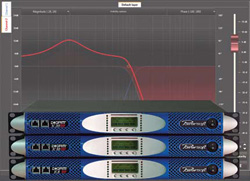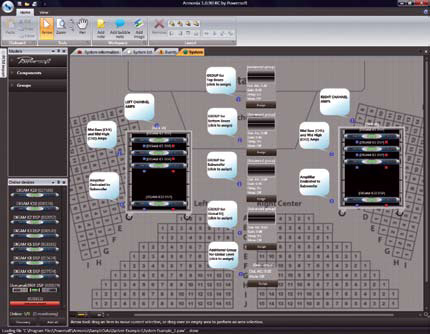
DSP Power
The final area of focus in the development of Armonía was in providing the capability to program and implement extensive DSP functions affecting both input and output signals.
For those amplifiers equipped with optional DSP cards, a greater range of features and facilities were made available including input and output equalization, alignment delays and FIR filters.
We developed the features list through the input of top industry engineers and system designers to address the real needs of delivering and implementing a sound system, keeping in mind that the amplifier itself was taking over the role previously held by external pieces of equipment.
Equalization was implemented to cover all aspects of system equalization.
As such, Armonía makes available up to three EQ layers of 32 filters each in the input EQ, as well as 16 EQ filters plus two crossover filters in the output EQ. In addition, DSP control was further enhanced by Armonía’s grouping feature which combines input EQ, input delay and input attenuation DSP parameters within a graphic interface that is easy to use.
Preset protection was assured through a multilevel locking feature with invisibility of parameters. The input EQ was designed to be used as either parametric or graphic, depending on the intended mission of the EQ.
Armonía’s DSP remote control also has the capability of importing frequency response curves as ASCII data from the most popular measuring software for an easy re-design of loudspeaker presets on location.
While the output EQ has a similar general appearance of the input EQ, it has several important differences.
The output EQ curve the amplifier employs was intended to be created from a speaker manufacturers’ data for the particular loudspeaker cabinets or arrays used in a system. It provides a range of hi-pass and low-pass crossover filters as well as 16 individual peaking filters.
It is also possible to import and export crossover/filter response curves. The available filters for crossover include Butterworth, Bessel, Linkwitz-Riley, FIR and Hybrid FIR filters with the turnover frequency fully adjustable for all types.
The filter slope was made selectable in 6dB/oct increments from 6 dB/oct to 48 dB/oct for Butterworth and Bessel types, and in 12 dB/oct increments from 12 dB/oct to 48 dB/oct for Linkwitz-Riley types. FIR and Hybrid FIR filters have slopes which are defined by the turnover frequency, so dedicated slope adjustment parameters are unavailable.
Signal delay capabilities allow the engineer to precisely tune the correct time delay for side fill, under balcony or any speakers that are set up beyond the main front of house system.
The delay functions can insert a per-channel fixed delay in the output equalizer as well as in the input equalizer. The primary use of delays added here is to time-align individual drivers in multi-way loudspeaker systems.
Delay values can be specified as time, in 0.01 millisecond (mS) increments up to 32 mS, or as distance in 1 millimeter increments up to 35-plus feet (10.9 meters).
The distance units may be changed to feet by selecting Imperial instead of International. The distance/ time conversion is based on a sound velocity value of 1,125 feet per second (343 meters per second) in dry air at 68 degrees F (20 degrees C).
The design challenges in creating an amplifier capable of becoming a technology platform controlled by intuitive, feature laden software were legion.
The result was the integration of real-world issues experienced with large sound systems, coupled with hard science, to yield a comprehensive software package.
Claudio Lastrucci is managing director of Powersoft.

